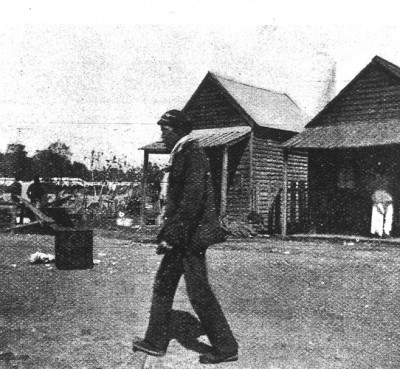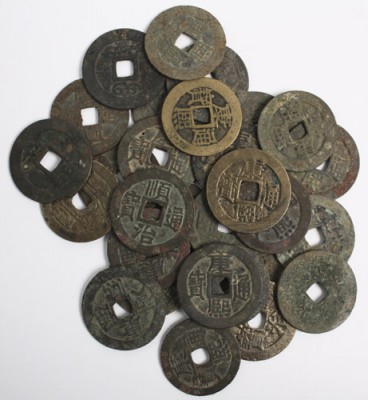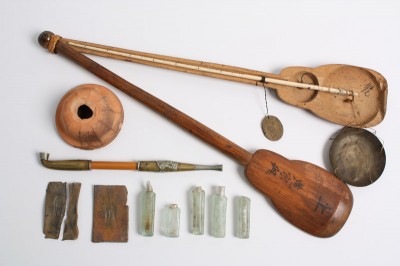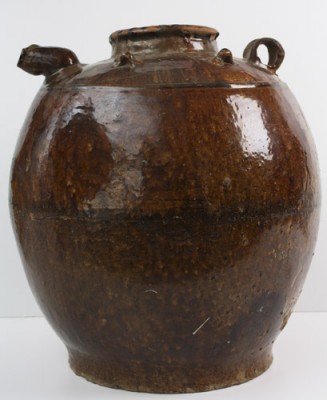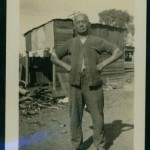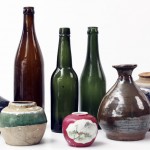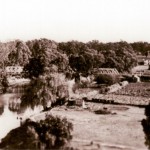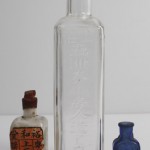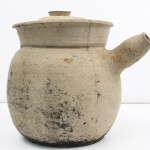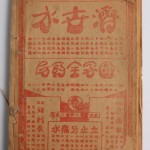Camp life
Much of the predominantly male Chinese population in the Riverina lived in self-contained camps, located on the fringe of the main towns and close to the main waterways. The largest camps were at Narrandera, Wagga, Hay, Deniliquin and Albury, with smaller ones at Hillston, Booligal, Gundagai and Tumut, and at the larger pastoral stations.
In 1884 a Parliamentary Report on the five largest camps was submitted by Sub-Inspector Martin Brennan and Quong Tart. The largest camp was at Narrandera on the banks of the Murrumbidgee River. It had 340 residents, of whom 303 were Chinese, nine European married women, ten children and 17 prostitutes. It had streets and lanes, stores, a temple, a very large cook shop, two lottery houses and several fan tan rooms. The Wagga camp was located on the banks of the Murrumbidgee River on Fitzmaurice Street. It had 223 residents, of whom 194 were Chinese, six European married women, one a Chinese married woman, 16 children and seven prostitutes. Built mainly of wood, with linings and ceilings of hessian and paper and mostly shingle roofs, the houses were very susceptible to fire. Serious fires occurred at Hay in 1893 and Narrandera in 1897, when all but five buildings survived, and at Deniliquin in 1900, when almost the entire camp was destroyed.
The camps were predominantly male domains, which meant that the men’s social lives were pursued largely outside a family environment and that sexual relations involved crossing the racial and cultural divide. Most social activity in the camps took place in the temples, lodges, gambling houses and opium rooms, although home visits and entertainments also occurred.
The predominantly masculine nature of these activities and the behaviour of many of the European women drew constant criticism. Some of the women, Brennan reported, had married Chinese men, appeared respectable, and kept aloof from the bad characters. They also showed great interest in the education of their children. However, the less respectable wives ‘made the lives of their unfortunate Chinese husbands miserable’ and when not at war with them, fought each other. He felt that it was the prostitutes and most of the disreputable married women who were the ‘principal cause of all the disturbance, robberies and crimes, which have transformed the Chinese camps into dens of immorality’. Nevertheless, as Brennan indicated, many Chinese-European family relationships and marriages were stable and successful, particularly where the families lived in the town proper rather than the camps.
Another aspect of the camps to attract criticism was the perceived lack of sanitation, which was often exacerbated by the poor drainage conditions in most of the camps. At Wagga in 1881 a local correspondent found that the Chinese lived in filth and dirt in overcrowded and ill-ventilated rooms and that the stench was ‘disgusting in the extreme’. Similar comments were made about most of the other camps. A report on the Albury camp in 1881 found that the kitchen, eating rooms, shops, sleeping places, and ‘fan tan’ apartments were clean, well ordered, ‘and smelt far sweeter than some back slums in European quarters’, but the disposal of nightsoil left much to be desired. Brennan reported that there were nicely furnished rooms occupied by well-to-do Chinese or some married Chinese in each of the camps but they were few compared with the many tenements which in hot weather must ‘breathe pestilence because of the neglect of all hygienic laws’.
Leisure
The leisure activities of Chinese men most frequently commented upon in the late nineteenth century were opium smoking and gambling. While no mention has been found of Chinese attendance at racehorse meetings in the Riverina, it was a popular activity with the Chinese elsewhere in NSW, and it can be assumed that the same must have been the case here: they were not excluded from participating. Many of the camp residents were also literate in their own language and brought books from China or purchased them from the city merchants and importers.
The principal game was “‘Pak ah pu’” or “‘my pow Chong’, commonly known as the “‘Chinese lottery’, which was run from banks financed by the wealthier Chinese; the other was Fan Tan. From the 1880s the proliferation of the lotteries drew constant criticism. At Wagga the main concerns were the large crowds of onlookers and gamblers, and the enticements to youths and the less well-off, including children. In 1890 similar concerns were raised at Hay where storekeepers at the camp did a large trade in lottery tickets, most of them being sold on the streets by agents appointed by the banks, and in the bush at Oxley, Maude, Booligal and other rural centres.
Opium smoking was another popular pastime, and to a large degree substituted for the drinking of alcohol, which was largely the preserve of Europeans. The use of opium in China dated back to at least the 1700s, and attempts by Chinese authorities to limit its trade failed. It followed the Chinese migrants overseas, and was commonplace in the Chinese camps in the Riverina and elsewhere in NSW. Implements and containers relating to its consumption have been found at a number of locations. Opium smoking was not, however, illegal.
By the early 1880s a few Chinese clergymen and respected merchants began to agitate for its prohibition. Quong Tart,, an active campaigner against opium, in 1884 claimed that opium smoking was the ‘fulcrum on which rests all vice, immorality and corruption within the Chinese’. Some local observers were sympathetic to the plight of the Chinese; and one letter to the editor of the Wagga Wagga Daily Advertiser in 1884 stated that the effects of excessive opium use were far less than for alcohol, and that it would be very unfair to deny the Chinese this ‘small luxury’.
Although large quantities of alcohol were purchased for use at their various festivals, the Chinese did not consume alcohol on the same scale as Europeans. Chinese men were rarely ever drunk and even more rarely prosecuted for such.
Food
Eating together was a means of cementing bonds and hierarchies with families and friends. All of the major camps had at least one cook house and sometimes boarding houses. Rice was the staple diet and complemented other foods such as chicken, pork, fish, beans and a variety of green vegetables, of which there were plenty in the Riverina, with its many market gardens. Tea was also an important staple as a drink. A rare account of culinary experiences by the Chinese on the pastoral stations was provided by George Gow, who stated that
Each man seemed to take his turn at cooking, and weird and wonderful were the dishes they concocted. Preserved ginger, all kinds of dried fish, and pork were on the menu; rice of course figured largely, but it was of a specially prepared kind. I have often heard it said that Chinamen could live on the smell of an oil rag, but it is a fallacy, they live exceedingly well – much better than Europeans under similar circumstances.
Along with the dietary staples a wide variety of other ingredients peculiar to Chinese cuisine was consumed. Two of the most common were soy sauce and ginger, the latter often given as a present on Chinese New Year. Along with the food came the distinctive Chinese cooking utensils, eating crockery and storage jars, such as the large brownware jars and celadon glazed bowls. Many Chinese residents also used European and locally manufactured foods and objects. Evidence of such sharing and mixing is available from much of the work done by archaeologists in Australia and elsewhere.

